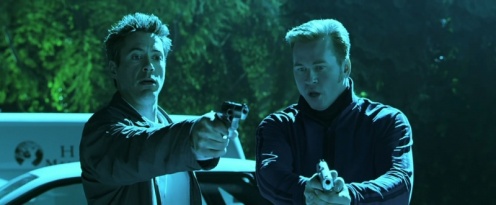{An excerpt from Shane Black’s KISS KISS BANG BANG}
—
Harry (Robert Downey Jr) and Gay Perry (Val Kilmer) are trying to get information out of a hostage.
HOSTAGE: “Look, I don’t know anything about a girl. Seriously. I was bluffing.”
HARRY: “You know what? I think that you are bluffing- right- now.”
Harry empties his revolver of all six bullets.
GAY PERRY: “Harry, what are you doing?”
As Harry places a single bullet back in the chamber…
HARRY: “Well, what I’m doing for the guy that likes to ‘bluff’ is playing a little game that I like to call ‘Am I bluffing?'”
Harry spins the cylinder, aims at his hostage:
HARRY: “You wanna play hard ball? I can do that. Where- is- the girl!”
–BLAM! The gun goes off, killing the hostage. Harry is appalled.
GAY PERRY: “What did you just do?”
HARRY: “I just- I put in one bullet, didn’t I?”
GAY PERRY: “You put a live round in that gun?!”
HARRY: “Yeah, there was like an 8 percent chance.”
GAY PERRY: “8 percent? Eight?! Who taught you math!”
Why am I so tickled by this scene? Because it’s a perfect illustration of a concept in screenwriting I like to call the “Exquisite False Expectation.”
We’ve seen this setup a thousand times. The gunman empties the cylinder, places a single bullet back in the chamber. This little game he’s about to play is really called ‘Russian Roulette.’ Naturally in this situation the gunman will aim at his hostage, pull the trigger- CLICK– an empty chamber means the hostage’s life is spared- for the moment! But could the bullet be in the next round? The tension grows with each trigger pull. However, the tension is diluted when the audience can accurately predict the result having seen it many times before. Sometimes the option lock runs out and the hostage is eventually killed. But what usually happens is the hostage can’t take the tension anymore and caves, giving in to the gunman’s demands.
Yawn.
The reason the KKBB scene elicits a response from the audience is not just because an event occurs that the audience didn’t see coming, but moreover, the audience was anticipating something specific that they’ve seen over and over again… but this time got something different.
It’s like the classic 1-2-3 joke structure where the first step establishes the setting, the second establishes a parallel to the first step- a direction- and thus an expectation for what will come next. But when you get to the 3rd step you are instead given a twist. Setup-anticipation-punchline.
(from Laura Kightlinger) “I can’t think of anything worse after a night of drinking than waking up next to someone and not being able to remember…”
a) “…their name…” (setup)
b) “…how you met…” (anticipation)
c) “…or why they’re dead.” (punchline)
Bodda-bing!
In the narrative setup we’re substituting jokes for tropes. In jokes we intuitively know the 1-2-3 structure but can still appreciate a good punchline. But in a movie trope, when the result is what we expected it to be it’s as if we’re hearing a joke for the umpteenth time- it’s as if the joke doesn’t have a punchline!
Wah-wah-waaah.
Lazy screenwriting results in audiences walking out going “There was nothing original in that movie.” Sure, it’s one thing to invent original stories where events occur that we haven’t seen before. But there’s something extra special about when a writer sets up a situation we have seen before and successfully turns our expectation of what will happen right on it’s predictable head!
Bodda-frickin-bing!
As a mentor of mine once said to me: “Well, if you can do that, then you can have the house in the hills.”
~ JW
Leave a comment
No comments yet.


Leave a comment